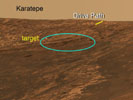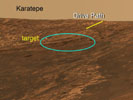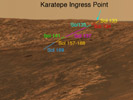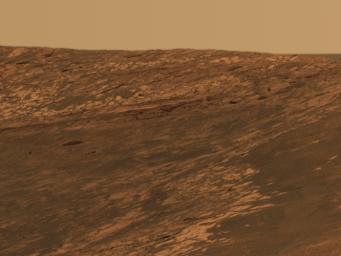 |  |  |  | |
| Figure 1 | Figure 2 | Figure 3 | Figure 4 |
Trekking Down 'Endurance' (sol 170, July 16, 2004)
In figure 4, the darker blue line in this approximate true-color mosaic from the
panoramic camera on NASA's Mars Exploration Rover Opportunity
shows the rover's position as of sol 170 (July 16, 2004). The rover is
located at the end of the blue portion of the line, about 10 meters
(32.8 feet) into "Endurance Crater." The rover took this image while
sitting on the opposite edge of the crater.
The image also shows the "Karatepe" ingress, where the rover began
ts traverse down into "Endurance Crater" on sol 159 (July 5, 2004). One
of the major goals motivating the rover team to carefully drive the rover
further down into the crater is to follow up on clues observed so far involving
the element chlorine and the mineral pyroxene. The rover has found that
chlorine and pyroxene (a signature of basaltic, or volcanic, rocks) increase
in concentration with deepening layers of rock. Scientists also hope to study
the dunes, or "ripples," visible at the bottom right of this image. These dunes
show strong signatures for basalt and could further develop the history of this
area of Meridiani Planum.
The Path into "Endurance" (sol 133, June 8, 2004)
Figures 1, 2, and 3 above are images from NASA's Mars Exploration Rover
Opportunity panoramic camera showing the rover's 6-to-7-meter
(20-to-23-foot) drive path into the crater called "Endurance," starting
near the target called "Karatepe." In figure 1, the yellow line at the
top illustrates the first part of the drive, a 1.2-meter (3.9-foot)
movement forward just enough to get all six of the rover's wheels into
the crater. The rover will then back up the same distance and examine
what the wheels did to the rocks. The following day, it will move
forward approximately 3.2 meters (10.5 feet).
In figure 2, the yellow line at the top illustrates the second part of
the drive, in which the rover drives forward 2.4 meters (7.8 feet) into
the crater before backing up to examine the soil and rock it just drove
over.
In figure 3, the yellow arrow at the top illustrates the last leg of the
drive, a forward movement into the crater, illustrated by the blue circle.
The drive began on sol 133 (June 8, 2004).

 Planetary Data System
Planetary Data System
















